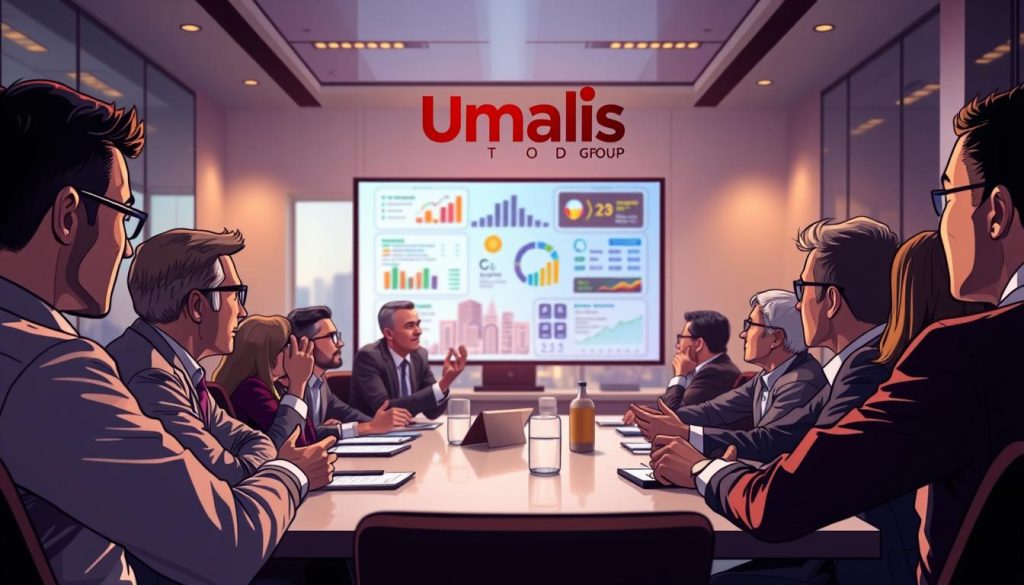Did you know the average attention span is now just eight seconds? That’s shorter than a goldfish’s! This startling fact from Microsoft research shows why making quick connections matters more than ever.
In today’s fast-paced world, you need to capture interest immediately. A well-prepared introduction can open doors to amazing opportunities. Whether you’re networking or seeking new ventures, your opening statement sets the tone.
This brief yet powerful summary helps you stand out in crowded spaces. It’s your chance to make a memorable impression when time is limited. You’ll learn to communicate your value clearly and confidently.
Mastering this skill transforms how others perceive you and your ideas. The right approach ensures you’re always ready when chance meetings occur. Your professional success often depends on these brief interactions.
Table of Contents
Key Takeaways
- Capture attention within seconds using a compelling introduction
- Communicate your unique value proposition clearly and concisely
- Adapt your message for different professional situations
- Build confidence in networking and presentation scenarios
- Use proven frameworks while maintaining authenticity
- Prepare for unexpected opportunities with a ready-to-share summary
- Transform brief encounters into meaningful connections
Understanding the Role of an Elevator Pitch
Many successful connections begin with a powerful 30-second introduction. This brief presentation serves as your professional handshake in conversation form. It’s designed to spark interest and open doors to future discussions.
What Is an Elevator Pitch?
Think of this introduction as your personal commercial. It summarizes who you are and what value you bring. The name comes from fitting it into a short elevator ride.
This tool works in many situations beyond actual elevators. You might use it during job interviews or when meeting potential clients. Effective networking often depends on having this ready.
Benefits for Business and Career Growth
A well-prepared introduction creates numerous advantages. It helps people understand your unique offerings quickly. This clarity builds confidence and professional credibility.
The benefits extend across both business and personal development. You’ll find yourself better prepared for unexpected opportunities. Strong first impressions lead to lasting professional relationships.
| Business Benefits | Career Benefits | Long-Term Advantages |
|---|---|---|
| New client acquisition | Interview confidence | Professional network expansion |
| Investor interest | Personal branding | Industry recognition |
| Partnership opportunities | Skill demonstration | Career advancement |
Mastering this skill shows respect for others’ time while highlighting your strengths. The investment in preparing your summary pays dividends throughout your professional journey.
Preparing for Your Elevator Pitch
A well-prepared summary starts with understanding two key elements. These components ensure your message resonates powerfully with listeners. Proper groundwork makes all the difference in professional settings.
Identifying Your Audience
Knowing your target audience is the essential first step. This understanding lets you customize your message for maximum impact. Different situations call for different approaches.
At networking events, your audience might include various professionals. Each group needs a slightly tailored approach. Research beforehand when possible to understand their needs.
Setting Clear Objectives
Define what you want to achieve with each introduction. Your goals might include securing follow-up meetings or building relationships. Clear objectives help focus your message effectively.
Align your aims with available opportunities in each situation. A casual event might focus on connection-building. A job fair would target specific employment prospects.
Understanding time constraints helps gauge your delivery length. Some situations call for quick 30-second versions. Others allow for more detailed 60-90 second summaries.
When you pitch to the right people, meaningful conversations follow. This approach leads to real business outcomes and professional growth.
Crafting an Authentic Message
Authenticity transforms standard business conversations into meaningful exchanges. The most powerful introductions feel natural rather than rehearsed. They create genuine connections that last beyond the initial meeting.
Balancing Professionalism with Personality
Your introduction should reflect who you truly are as a person. Avoid sounding like a corporate robot reading from a script. Instead, let your unique perspective shine through naturally.
Use clear, accessible language that everyone can understand. Skip the technical jargon that might confuse your audience. Focus on how you solve problems for others.
As a business owner or professional, your message should balance competence with warmth. Show both your expertise and your humanity. This combination builds trust faster than polished corporate talk.
Personal touches make your pitch memorable without oversharing. Select recent, relevant details that demonstrate value. Keep the focus on how you help people achieve their goals.
When your elevator pitch feels genuine, it invites real conversation. People respond to authenticity with engagement and questions. This creates dialogue instead of one-sided presentations.
Advanced Elevator Pitch Crafting Strategies

The most memorable business introductions focus on solving problems rather than selling products. This approach transforms your message from a simple summary into a compelling conversation starter.
Focusing on the Customer and Problem/Solution
Great marketing always puts the customer first. Instead of talking about your features, start with their challenges. This builds immediate connection and shows you understand their world.
The problem-solution-proof framework works perfectly here. First, identify a real issue your audience faces. Then present your approach as the answer. Finally, share evidence that your method delivers results.
When describing the problem, use examples they’ll recognize from daily work. Make it feel urgent and relevant. This demonstrates you speak their language and grasp their situation.
Integrating Value Propositions Effectively
Your value proposition should answer one key question: « Why should they care? » Connect your unique strengths directly to outcomes that matter to them. Avoid vague claims about being « the best. »
Position yourself as the guide who helps customers achieve success. Make them the hero of the story rather than focusing on your own achievements. This creates a partnership mindset instead of a sales pitch.
Effective integration means every element serves the customer’s needs. Your introduction becomes a solution-oriented conversation that invites further discussion and collaboration.
Building a Strong Value Proposition
What truly separates effective communicators is their ability to articulate unique value clearly. Your value proposition answers why someone should choose you over alternatives. It’s the core message that makes your introduction compelling and memorable.
Defining Your Unique Value
Your distinct advantage might come from specialized expertise or a unique approach to solving problems. Focus on outcomes rather than features when defining your value. Customers care more about results than your process.
Consider what combination of skills and experience you bring to the work. This isn’t about claiming superiority but identifying specific benefits others don’t offer. For example, your customer service philosophy could be your differentiator.
Showcasing Tangible Proof and Results
Specific numbers transform claims into credible promises. Statements like « increased engagement by 40% » carry more weight than vague improvements. Real-world success stories provide social proof that builds trust.
When you can point to measurable outcomes—time saved, efficiency gained—you demonstrate real business impact. One customer regained 10% of their daily time after implementing our solution. This fact makes your value proposition undeniable.
Utilizing Examples and Templates for Impact
Looking at concrete examples from various fields provides invaluable insights for creating your own compelling summary. These real-world illustrations show how professionals pack maximum value into brief conversations. They demonstrate what works across different industries and situations.
30-Second Pitch Examples
Effective elevator pitch examples show how to communicate value quickly. Consider this insurance professional’s approach: « You know how people rarely review coverage when circumstances change? I ensure insurance always matches current needs for peace of mind. »
Another powerful example comes from marketing. A student might say: « I specialize in digital campaigns that boost engagement. Recently, I helped a local business increase social media interaction by 40%. » These pitch examples prove that specific results make introductions memorable.
Transforming Templates into Personal Stories
Templates provide helpful starting points, but personalization creates real connection. The best examples show how generic structures become unique stories. They reflect your specific experiences and value.
Study various pitch examples to understand successful patterns. Then adapt them to your personality and goals. This approach saves time while ensuring your message feels authentic.
| Industry | Key Problem Addressed | Measurable Result |
|---|---|---|
| Insurance | Outdated coverage | Full financial recovery |
| Marketing | Low engagement | 40% increase |
| Technology | Inefficient systems | Time savings |
These examples demonstrate how to make every second count. They show the power of specific, results-focused communication in limited time frames.
Tailoring Your Pitch for Different Settings
Your introduction strategy needs to adapt to different professional environments to maintain effectiveness. The same message that works at casual gatherings might not suit formal business meetings. Understanding context helps you make meaningful connections in any situation.
Insights for Networking Events
Networking events require a conversational approach rather than a formal presentation. Focus on building genuine relationships rather than making immediate requests. Ask questions about others’ work and find common interests.
These gatherings let you explore potential collaborations naturally. The goal is creating dialogue that could lead to future opportunities. Good networking means listening as much as speaking.
Adapting for Job Interviews and Formal Meetings
Job interviews demand more structured introductions that highlight relevant experience. Use industry-specific terminology that shows your expertise. Connect your background directly to the company’s needs.
Formal business meetings require polished, results-focused communication. Demonstrate your understanding of the other party’s challenges. Your professionalism here builds immediate credibility.
Creating Versatile Virtual Pitches
Virtual settings present unique challenges with distractions and technical issues. You need to be more engaging through video than in person. Maintain strong eye contact and clear vocal delivery.
Adapt your approach for different online events and platforms. The core message stays consistent while delivery adjusts to the medium. Practice makes virtual communication feel natural and effective.
Mastering Delivery and Nonverbal Communication

Nonverbal cues often communicate more powerfully than your actual words. Your body language, facial expressions, and vocal qualities significantly influence how your message lands with any audience. These elements work together to create a complete impression.
Improving Body Language and Eye Contact
Strong eye contact conveys confidence and sincerity when speaking to a person. Maintain natural gaze that shows engagement rather than staring uncomfortably. Your physical presence should feel open and welcoming.
Stand with good posture and avoid crossing your arms defensively. Use natural hand gestures to emphasize key points. Orient your body toward your listener to demonstrate full attention.
Enhancing Voice, Tone, and Pace
Your vocal delivery represents critical communication skills that can make or break your message. Speaking too quickly suggests nervousness, while a slow pace may lose your audience‘s interest. Aim for a conversational rhythm with natural variation.
Choose impactful language that creates vivid mental images rather than abstract jargon. Your tone should match the setting—enthusiastic for networking, professional for formal meetings. Practice until your delivery feels completely natural.
Remember that effective communication skills vary across cultures. Always be mindful of your specific audience and adapt accordingly. The right delivery transforms your elevator pitch into a genuine connection.
Leveraging Digital Platforms and Social Media
Modern professional connections increasingly happen through screens rather than handshakes. Your online presence now works continuously to create opportunities. Digital platforms extend your professional introduction beyond face-to-face meetings.
These tools allow you to make impressions on potential employers and collaborators worldwide. Effective management of your digital identity becomes crucial for career advancement. Your profiles serve as always-available introductions to your professional value.
Optimizing Your LinkedIn Profile
Your LinkedIn profile functions as your permanent professional summary. The about section should mirror your best verbal introduction. Include relevant industry keywords that recruiters search for regularly.
Showcase your key skills and measurable achievements clearly. This approach helps organizations understand your fit quickly. A well-optimized profile can attract job offers without active searching.
Engaging on Virtual Networking Platforms
Virtual networking requires adapting your approach for digital environments. Online events demand extra clarity since nonverbal cues are limited. Be concise in text-based interactions while maintaining professionalism.
Platforms like LinkedIn offer opportunities to demonstrate expertise through content sharing. Thoughtful comments on industry discussions reinforce your professional story. Consistent engagement builds your reputation over time.
Effective business communication online requires understanding each platform’s norms. Different digital spaces serve different networking purposes. Your approach should match the platform’s culture while maintaining your authentic voice.
| Platform Type | Primary Use | Best Practices |
|---|---|---|
| Professional Networks | Career Development | Complete profile, industry engagement |
| Virtual Event Platforms | Knowledge Sharing | Active participation, follow-up connections |
| Specialized Communities | Skill Demonstration | Content contribution, thoughtful interactions |
Building a strong freelance social media presence complements your overall digital strategy. Consistency across platforms tells a coherent professional story. This integrated approach maximizes your visibility and connection opportunities.
Conclusion
Your professional journey is filled with moments where a concise, powerful introduction can change everything. Mastering this skill ensures you’re always ready to make a strong first impression.
A great summary isn’t a rigid script. It’s a flexible tool that clearly communicates your unique value. The real art lies in personalizing your message to resonate with different audiences.
Remember to focus on the problems you solve for others. This approach makes your introduction memorable and engaging. It turns a simple question into an opportunity for meaningful connection.
Keep practicing until your delivery feels natural and confident. Your ability to articulate your value clearly in seconds is a powerful asset. It opens doors to new jobs, clients, and collaborative partnerships.
Combine your polished introduction with effective networking strategies for maximum impact. Start refining your message today—your next big opportunity could be just one conversation away.
FAQ
What exactly is an elevator pitch?
Think of it as your personal or professional story told in the time it takes to ride an elevator—about 30 to 60 seconds. It’s a brief, compelling summary that introduces who you are, what you do, and the value you bring. The goal is to spark interest and open the door for a deeper conversation.
Why is having a good elevator pitch so important for my career?
A strong pitch is your secret weapon for making a memorable first impression. It helps you stand out at networking events, during job interviews, or when meeting potential clients. It clearly communicates your unique skills and goals, turning chance encounters into valuable opportunities.
How can I make my message sound authentic and not too rehearsed?
The key is to balance professionalism with your natural personality. Write your core message down, but practice it conversationally. Use language you would normally use and focus on telling a short story about your passion or a problem you solve, rather than just listing facts.
What’s the best way to start crafting my pitch?
Begin by identifying your target audience and your main objective. Ask yourself: Who am I talking to, and what do I want them to do or remember? This focus will help you tailor your message to be relevant and impactful for each specific situation.
How do I highlight my value proposition effectively?
Connect your skills directly to a problem you solve for your customer or industry. Instead of just saying what you do, explain the positive outcome or result you deliver. For example, « I help small businesses save time by streamlining their scheduling process. »
Can you give me an example of a 30-second pitch?
Absolutely! Here’s a simple structure: « Hi, I’m [Your Name]. I work with [your target audience] to help them [solve a problem] by [your unique solution]. For instance, we recently helped a client [achieve a specific, tangible result]. I’d love to explore if this could work for you. »
How should I adjust my pitch for a virtual meeting versus a live event?
For virtual settings, your delivery needs to be even more concise and engaging. Make sure your lighting and audio are clear, and practice looking directly at the camera to simulate eye contact. For live events, you can use more body language and read the room’s energy to adjust your tone.
What are common mistakes to avoid when delivering my pitch?
The biggest pitfalls are speaking too fast, using industry jargon, and making it all about you instead of the listener. Remember to breathe, pause for questions, and keep the conversation two-sided. It’s an introduction, not a sales monologue.
How can I use my LinkedIn profile to support my elevator pitch?
Your LinkedIn profile is your digital handshake. Make sure your headline and « About » section mirror the key points of your verbal summary. Use a professional photo and include specific achievements or endorsements that provide proof of the value you talk about in person.





